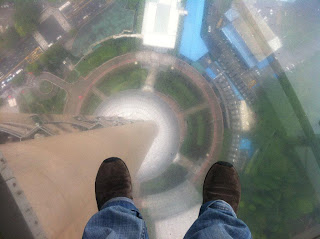The area we were in is a newly developed area of Shanghai called Xitianqong and many old houses have been crashed down to make way for 30+ storey high rise residential apartments. The old China would most likely chuck the people on the streets however the new China 'rehoused' the people who were living there in the new apartments. We arranged a tour through one of the apartments which occupied the top 3 floors of one of the towers and cost in the vicinity of $10.5m Australian dollars. It didn't come as a surprise to learn that it belonged to the Chairman of the Board of the development corporation.
 These residential complexes are huge and most have significant grounds and amenities built nearby. One had a building called the 'Clubhouse' which included a pool, 2 basketball courts, gym, climbing wall, business centre, karaoke rooms, band practice rooms, function rooms and business centre. The picture is of the lifeguard employed to ensure no-one drowns (he's at the far end). As you can see, there is no-one in the pool so I'm guessing he notches that up as 100% safety record today.
These residential complexes are huge and most have significant grounds and amenities built nearby. One had a building called the 'Clubhouse' which included a pool, 2 basketball courts, gym, climbing wall, business centre, karaoke rooms, band practice rooms, function rooms and business centre. The picture is of the lifeguard employed to ensure no-one drowns (he's at the far end). As you can see, there is no-one in the pool so I'm guessing he notches that up as 100% safety record today. The area is also famous for being where the first Communist party meeting took place in 1921 and 2011 is the 90th anniversary of that meeting. The modest house where that meeting took place is still preserved today. If those communist party leaders were alive today I don't think they'd approve of the area they held that first meeting in. The precinct the house is situated in is probably one of the most materialistic, capitalist areas of Shanghai, a far cry from the minimalist, one wage for everyone doctrine of 1920s China. It does show how far the extreme left has swung back towards the centre....if not a little past the middle onto the right side.
The area is also famous for being where the first Communist party meeting took place in 1921 and 2011 is the 90th anniversary of that meeting. The modest house where that meeting took place is still preserved today. If those communist party leaders were alive today I don't think they'd approve of the area they held that first meeting in. The precinct the house is situated in is probably one of the most materialistic, capitalist areas of Shanghai, a far cry from the minimalist, one wage for everyone doctrine of 1920s China. It does show how far the extreme left has swung back towards the centre....if not a little past the middle onto the right side.
These complexes also include significant office space as these bring in large tax dollars for the Government. These office complexes are extremely well-catered for with a unique service for tired Chinese businessmen whereby there are free girls in the lobby. This sort of thing used to be seen more in the seedier side of town but seems quite commonplace here. The picture to the left shows what I mean. The sign on the table says 'Please Take One' (just in case you got greedy). Hang on, it appears I'm mistaken - the sign really means 'please take a seat'....well I would if there weren't so many girls on it.

































